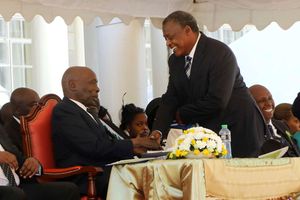
Al-Shabaab militants in Somalia.
| File |AFPNews
Premium
How Al-Shabaab made Sh1.3bn in nine months
What you need to know:
- The report says despite sanctions, Al-Shabaab has found ways of moving millions of dollars it collects through the banking system of Somalia.
- The new UN report shows that a weak Mogadishu government has enabled the group to thrive financially.
- In the port city of Kismayo, which is controlled by Amisom soldiers, Al-Shabaab made $5.8 million from taxing businesses.
Somalia-based terrorist group Al-Shabaab generated about $13 million (Sh1.3 billion) between December 2019 and August, a new report says.
According to the report by the United Nations Security Council expected to be released this week, the group raised the money through extortion and illegal taxes.
The report says despite sanctions, Al-Shabaab has found ways of moving millions of dollars it collects through the banking system of Somalia, investing in real estate across the region.
Friday marks the beginning of the tenth year since Kenya Defence Forces (KDF) soldiers invaded Somalia in an effort to create a buffer zone between Al-Shabaab and Kenya’s borders.
The incursion, which was expected to take a few months, has extended to a decade after KDF joined the African Union Mission in Somalia (Amisom).
KDF Day
The country celebrated KDF Day Wednesday.
“As we recall our journey, I urge you not drop your guard. A secure Somalia able to provide security in its borders translates to a peaceful East Africa,” Defence Cabinet Secretary Monica Juma told the soldiers.
“The terrorist group remains a threat but it has been greatly degraded. Your contribution to Amisom remains a game changer.”
And while many studies say the intervention of several agencies in Somalia has weakened Al-Shabaab over the years, the new UN report shows that a weak Mogadishu government has enabled the group to thrive financially.
“Al-Shabaab remains in a strong financial position and is generating a significant budgetary surplus, some of which is invested in property and businesses in Mogadishu,” says the report seen by Reuters.
Most of this money was generated through extortion of businesses in areas where Al-Shabaab controls in southern Somalia while the rest came from investments made by the group.
Kismayo
In the port city of Kismayo, which is controlled by Amisom soldiers – with KDF placed in charge – Al-Shabaab made $5.8 million from taxing businesses.
The group also made $2.4 million during that time through road checkpoints in Lower Jubba.
Jubbaland was initially controlled by Al-Shabaab but is now under the leadership of Sheikh Ali Madobe, a key ally of Kenya.
Additionally, the group made $3 million, which was paid to two bank accounts it controls.
The money came from retailers, car dealers and shipping agencies.
It is the use of the formal banking system to receive and distribute money that has shocked a UN panel of experts based in Nairobi that has been monitoring Al-Shabaab since last year.
“Al-Shabaab’s use of formal banking systems enables the immediate transfer and distribution of large amounts, including in areas it no longer directly controls, eliminating the risk of physically transporting cash across hostile territory,” the New York Times quoted the report.
Banks monitored by the experts over the period failed to make disclosures about the suspicious transactions to Somalia’s Financial Reporting Centre.
Most of the money was invested in real estate and financing the terrorist group’s elite Amniyat unit, which specialises in gathering information, carrying out assassinations and staging suicide attacks.





